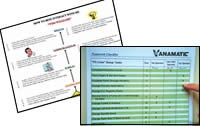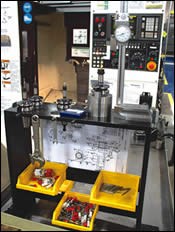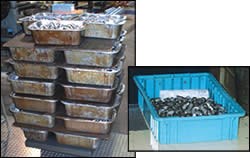Integrating Machining Centers Into The Work Flow
Often, the need for post-process machining becomes a bottleneck in the production shop. The high-volume primary machines often outpace the ability of secondary equipment to keep up. Here’s how one shop revamped its work flow to achieve production balance with a minimum investment.
Vanamatic Company (Delphos, Ohio) is no stranger to this magazine. We’ve covered this family-owned screw machine shop in the past with a story about setup reduction methods employed on the shop’s Conomatic multi-spindles. Taking change-over from 8 hours plus to less than 2 hours on a 1 5/8 VNA was impressive. As I found out on my most recent visit, this time has been halved again to less than an hour on this machine.
However, a funny thing happened with the successful setup reduction times. The ability to more efficiently crank parts on the multis caused an imbalance downstream in the production process. For some of Vanamatic’s multi-spindles, secondary operations are part of the process. The other machines drop off parts complete.
Previously, the amount of time needed to change-over the multi-spindles allowed the secondary department time to catch up to the primary machine production. However, with so little setup time available, the result was a serious buildup of work-in-process often requiring overtime to catch up.
Adam Wiltsie, Vanamatic’s manufacturing engineer, began noodling on this problem and devised a manufacturing cell built around the Conomatic and a new Chevalier vertical machining center, along with a tapping machine and vibratory deburring machine. “In our approach to the cell,” Adam says, “it was quickly apparent that simply sticking machines into an area and calling it a cell was not the solution. Making it work was a much broader issue than simple proximity.”
One Station At A Time
In the cell, a multi-spindle screw machine feeds three other machine workstations. A primary goal for revamping this secondary operation cell was to institute a smaller batch process flow to get better balance among the different machines.
In the old system, each secondary operation, the drill, tap or vibratory, had an inventory location attached to it. Work-in-process, three to four pans with 500 to 1,000 parts each, would pile up at each of these necessary locations. In effect, the pan size determined the batch size. “In our old batch sizes, it might take 35 hours to go from the screw machine to finished goods,” Adam says. “Now it only takes 5 to 6 hours to go through the cell.”
Smaller batch process flow reduces high work-in-process, reduces late deliveries and expedites shipments along with lowering the need for “emergency stock” while providing the shop with much better control over work flow. Simply replacing the part pans that defined a batch with smaller pans and eliminating the inventory holding locations helps streamline the smaller batch work flow. Only the number of pans necessary to maintain the work flow are located in the cell.
"Among our first concentrations was streamlining each workstation before tackling the whole cell,” Adam says. For example, some of the parts in the family require a cross hole drilled on two sides. This operation was the slowest and least efficient of the three post-process workstations. As the primary bottleneck in the work flow, it’s the workstation that received the most attention.
To get the ball rolling, Vanamatic upgraded to a CNC vertical machining center. The new machine’s higher spindle speeds of up to 15,000 rpm allowed a tooling switch from a left-hand twist drill to a carbide end mill, which gave a tool life increase from 400 parts per drill to 3,000 parts per mill and a faster cycle time.
The machine’s larger worktable, 18 inch by 14 inch, allowed Adam to go to work on the flow issue at this station. “Our old machining center was fixtured to handle one part at a time, and it had no toolchanger,” Adam says. If we moved from one part size in the family to another, the fixture and drills needed to be changed out.”
The hole sizes vary from 0.047 inch to 0.130 inch. Using an end mill at the high spindle speed eliminates concern about a burr in the hole. “It pretty much turns the chips to dust,” Adam says. “We also installed a tool presence detector in the machine’s workzone to alert the operator in case a tool breaks.”
Adam devised and built a tray system for use on the new Chevalier. Like a pallet system, two trays are rotated in and out of the machining center. One tray is loaded with parts and ready while the second tray is being machined.
Key to the design of these trays is that no adjustments are provided. Each tray handles 12 parts at a time and uses “poke-yoke” to ensure proper part placement into the tray. This one-way fixturing system not only reduces the skill level needed to run the parts, but also functions as a quality assurance measure. The design of these trays is scalable for future families of parts.
As the parts come off the machining center, a simple go/no-go gage is used to double check the location of the drilled holes and confirms their presence on the finished parts. Good parts are dropped through a hole in the worktable into a pan below, and any bad parts are separated into a different pan.
The machining center workstation is also equipped with a tool presetter to eliminate the need to touch off new tools that are loaded into the machining center. Each of the eight part families currently running across the machining center takes a different hole size. To expedite change-over, preset tools are racked and marked for each part and stationed next to the machining center for easy access.
While the machining center workstation received most of the attention during the equipment upgrade phase, the tapping center was also upgraded to help keep production flow balanced. Adam, who designed the tapping machine, equipped it with a rotary table for faster processing. The vibratory deburring operation was not really an issue for work flow, but it, too, benefited in efficiency from reduced batch sizes passing through the cell. These changes allow finished goods to move through the cell the same day. Moreover, smaller batches allow Vanamatic to reduce leadtime at outside processing by allowing use of UPS instead of bulk shipments on common carriers.
However, getting the equipment in place was only phase one.
Manning The Cell
Like most manufacturing shops, Vanamatic highly values its employees. Finding and keeping good people, with the skill sets necessary for precision metalworking, is an ongoing challenge.
Choosing the right personnel to operate within the team environment necessary for the cell to operate at maximum efficiency led the management team at Vanamatic to re-evaluate how it deployed its skilled operators. “Historically, our people were somewhat vertically integrated based on the job they did,” Adam recalls. “We had very little cross-training. Our screw machine operators focused on the screw machines and production coming off of them. Our secondary operation people did their jobs without much interaction with the other functions in the production flow. For this cell, we had to change that.”
The question, of course, is, “How can shops actually match the best person to a given task?” Vanamatic uses PI (predictive index) to do just that. Step one is to define the characteristics of a job. For example, the kind of work involved in running a secondary operation is different from running a screw machine. Once the job function is analyzed, the personnel are given a PI test that looks at several personality preferences as they relate to working, which allows a much better match of individuals to job functions. Everyone employed at the company, management included, has taken the PI test. The PI profiles are available to everyone.
"This program gives insight on how best to work with other people in the plant,” Adam says. “We actually post each member’s PI results in the cell so, for example, the members know who is more verbal versus visual, and they know who shows creativity versus someone who does not and so on. The end result is a better understanding among the team members as to the tendencies or preferences, strengths and weaknesses of each individual. It’s made for a much more harmonious transition from vertical departmentalization to a team approach within the cell.”
In a cellular operation, the team is the focus, not the individual. Therefore, Vanamatic cross-trains each member of the team in each of the job functions within the cell. For example, the screw machine operator can run the machining center and vice versa. The team members allocate the work among themselves so each member stays within his comfort area doing the job he or she prefers, most of the time.
Now, however, when the screw machine needs to be set up to run a new job, all of the team members jump on the setup, and that has resulted in a significant reduction in change-over time, which was pretty fast to begin with. “The operators enjoy the change of pace provided by doing different jobs in the cell,” Adam says. “It’s improved morale and created momentum in the shop to do more cells in other areas.”
The improved work flow derived from the process changes—smaller batch processing, multiple part processing using the trays and rotary table tapping machine—free the other team members to help out with change-overs. Adam says they approach these tasks like a NASCAR pit crew, trying to improve over the previous time.
From Slowest To Fastest
When Adam and Vanamatic started revamping the cell, the machining center drilling operation was the bottleneck. The machine then in use was old and unreliable; the fixturing accepted one part at a time and was difficult to run and adjust. The primary machine in the cell, the “Cone,” outproduced the secondary operations causing a built-up work-in-process. The operation of the cell was departmentalized with little or no cross-training or communication among the various operators—setups were the individual’s problem.
As a result of the machining center upgrade, reduced batch sizes, a team approach to the operation of the cell, and the efficiencies from improved machining practices implemented in the drilling operation, it has gone from the slowest process step to the fastest. Now the primary machine in the cell—the screw machine—has become the slowest, which is good. Work flow through this cell for its family of parts is balanced to the point work-in-process is reduced to no more than a few hours from start to finish compared to the days it previously took.
Tallying Up The Results
At the end of the day, what has this cellular approach wrought for Vanamatic? The balanced work flow provided by the integration of the machining center, tapping machine and vibratory has increased productivity to a point where the cell went from working 96 hours per week down to 80. That opened up 16 hours per week of extra capacity in the cell, which quickly filled with new work.
Three new families of parts have been added to the production mix to equal 20 different parts. Production volume for this cell has increased by 18 percent (from 805,149 to 981,064 parts) with no additional labor costs. Vanamatic has increased its sales for parts running through this cell by 28 percent, again with no additional labor costs.
Before the upgrade, the cell ran at 65-percent efficiency. Now it is running at 85- to 90-percent efficiency. With the lean practices, organized work areas, batch reductions, palletization (12 parts at a time across the machining center) and team setups, change-over from job to job has gone from 2 hours to 40 minutes on the screw machine and from 1 hour down to 20 to 30 minutes on the secondary machines.
All this makes the cell more nimble and responsive. It has also reduced customer leadtime by 3 to 5 days. “We can, if necessary, crank an emergency order through this cell in a day,” Adam says. “We generally try to avoid it, but the capability is there because of the work we’ve done to balance flow across these machines.”
Morale has also improved for the team members in this cell. Their jobs are easier and more interesting because of the variety of work available. It’s an improvement over the monotony of running a single machine all day.
Some Lessons Learned
As Vanamatic implements this integrated approach in other areas of the shop, which is ongoing, the company has learned a few lessons with the prototype. For example, when transitioning to the new cell’s equipment, it was important to move the old machinery out of the area. “We saw a tendency to use the old machines as a fall back in the cell,” Adam says. “So we moved them to another area of the shop. The machines are still available if absolutely necessary, but having them physically out of the area discourages using them regularly.”
The shop learned to organize the work area around lean principles, including 5S. They labeled everything in the cell and created a place for it to reside, which reduces clutter and improves efficiency. Only things necessary for the work are allowed in the cell.
The team members must have clearly defined job functions, especially when it comes to setups. Based on their PI profiles, the members know who is best as a wrench person, tool-setting person and paper person. Like a pit crew, everyone knows their job—different people jack the car, change the tire and fill the tank.
For Vanamatic, this integrated manufacturing system has produced dramatic productivity results, helping them continue to compete with a minimal out-of-pocket cost (a new machining center). The results speak for themselves.
Related Content
Does a Scanning Probe Make Sense on a Swiss-Type?
Swiss-types have limited tooling capacity, but there can be advantages to giving up some of that capacity to take advantage of a touch probe — in fact, a scanning probe — to enable in-process part measurements.
Read More5-Axis Machining Centers Transform Medical Swiss Shop
Traditionally a Swiss machine shop, Swiss Precision Machining Inc. discovers a five-axis machining center that has led the company to substantial growth. (Includes video.)
Read MoreIncreased Competition Calls for Smarter Solutions
Engineered for efficiency, SW Machines offers customers a full suite of horizontal machining centers and the automation needed for high-volume, high-precision manufacturing.
Read MoreLaser Technology "Turns" into a Turning Tool
This new technology uses a laser to act as a cutting tool to "turn" parts from solid barstock. This high-speed precision turning machine is especially useful for micromachining, enabling high accuracy for small, complex parts that are often delicate and difficult to machine when implementing conventional turning processes.
Read MoreRead Next
How To (Better) Make a Micrometer
How does an inspection equipment manufacturer organize its factory floor? Join us as we explore the continuous improvement strategies and culture shifts The L.S. Starrett Co. is implementing across the over 500,000 square feet of its Athol, Massachusetts, headquarters.
Read MoreFinding the Right Tools for a Turning Shop
Xcelicut is a startup shop that has grown thanks to the right machines, cutting tools, grants and other resources.
Read More


























